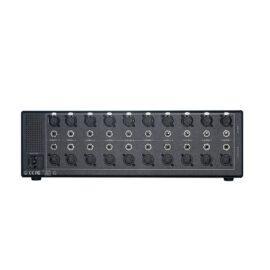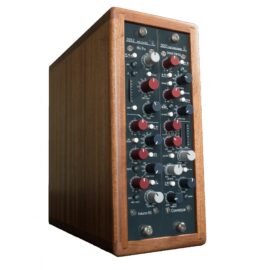Outboard equipment
Outboards in audio equipment are external devices that are used to process audio signals outside the main unit itself. These units can be preamplifiers, equalizers, compressors, reverb units, delay units, and other effects processors, which are usually separate from the main unit, such as a mixer, amplifier, or receiver.
Outboard equipment can come in a variety of form factors, including rack-mounted units, pedals, desktop units, and boxes. By using outboard equipment, you can achieve greater flexibility and quality in the processing of audio signals, as you can choose specific devices that are best suited for certain purposes, and you can also adjust and fine-tune the processing of the signal more precisely.
Outboard equipment for sound production
Outboard equipment is used to process audio signals and add various effects and treatments to the sound. Some of the most common uses of outboard equipment include:
Preamplifiers: These are used to amplify the weak signal from microphones and instruments so that it can be processed by other devices in the sound system, such as mixers and recorders.
Equalizers: These are used to adjust the frequency response of audio signals by cutting or boosting certain frequency ranges. This can be used to correct for problems with room acoustics, or to add creative effects to the sound.
Compressors: These are used to reduce the dynamics of an audio signal by reducing the difference between the high and low sound levels. This can be used to increase the average volume and to prevent overloading of recorders or amplifiers.
Reverb Units: These are used to add timbre and reverberation to the sound as if it were recorded in a specific room or environment.
Delay units: These are used to add echo and repetition to the sound, which can be used for creative sound processing and to achieve a greater sense of space and dimension in the sound.
These are just some of the most common uses for outboard equipment, but there are many other types of devices and effects that can be used to process audio signals and add creative effects to the sound.
Outboard equipment for professionals
Many musicians and sound engineers use outboard equipment as part of their sound production process. It is especially common in studio recording and live sound production. Here are some examples of musicians and bands who use or have used outboard equipment:
- The Beatles: The group used a variety of outboard equipment, including compressors and equalizers, in their studio recordings in the 1960s.
- Pink Floyd: The band used a variety of outboard equipment in their sound production process, including analog synthesizers and reverb units, to create their signature sound.
- Radiohead: The band has used outboard equipment in their studio recordings and live sound production, including effects and synthesizers.
- daft punk: The electronic music duo used a variety of outboard gear in their production, including synthesizers and sequencers, to create their signature sound.
- Quincy Jones: The music producer has used outboard equipment in many of his productions, including compressors and equalizers, to create a well-balanced and dynamic sound.
These are just a few examples of musicians and bands using outboard gear. There are many others who also use this type of equipment as part of their music production and audio production.

What type of outboard equipment should I use?
The choice of outboard equipment depends on a number of factors, including the type of music or sound production you are working with and the specific needs and wishes for the sound. Here are some considerations to help you choose the right outboard equipment:
Audio production needs: What type of audio production do you work with? Is it studio recording, live sound production or something else entirely? Each type of sound production may require different types of outboard equipment.
Sound result: What do you want to achieve with the sound? Are you looking for more clarity, more warmth or more reverb? Each type of outboard equipment can provide different effects and treatments to the sound.
Budget: What is your budget? Outboard equipment can vary in price from a few hundred kroner to several thousand kroner, depending on quality and functions.
Quality: What quality do you want on your equipment? Are you looking for professional equipment or hobby equipment? It can also influence your choices.
Compatibility: Always check whether your chosen outboard equipment is compatible with your existing audio equipment and software. It can be important to make sure that the equipment can cooperate optimally.
These are just some considerations that can help you choose the right outboard equipment. It may also be a good idea to seek advice from a professional sound engineer or musician if you are unsure of which type of equipment best suits your needs.
The most popular Outboard equipment
Here are some examples of some of the most common types of outboard equipment used in audio production:
Compressors: These devices are used to regulate the dynamics of the sound by reducing the volume of the high signals and amplifying the low signals. Popular brands include the Universal Audio 1176, LA-2A and SSL G Series Bus Compressor.
See our selection of compressors.
Equalizers: These devices are used to adjust the frequency response of the sound by amplifying or reducing certain frequency ranges. Popular brands include SSL E Series EQ, API 5500 and Neve 1073.
See our selection of Equalizers.
Reverb units: These units are used to add reverberation to the sound by simulating natural surroundings. Popular brands include Lexicon PCM, Eventide H8000FW and TC Electronic System 6000.
500 Series: One of the best things about the 500 Series modules is their versatility and flexibility. Because they are modular, 500 Series modules can be easily added to or removed from a recording studio setup and can be mixed and matched for a particular project.
See our 500-series equipment - by clicking here.
Mastering: In mastering, which is the final process in any sound production, the finished mix is refined. This is done by improving the overall sound, ensuring uniformity for all songs on an album, and preparing the production for distribution in the correct format.
See our Mastering equipment here.
Pre-amps: Pre-amplifiers are an important part of any audio production. Preamps are used to amplify the weak electrical signal coming from a microphone, instrument or other sound source before the signal is passed on to a sound card, mixer or other devices in the audio chain.
Humming: Humming is an important part of sound production as it allows different sound elements to work together as a whole. For example, a music production may have separate audio tracks for drums, bass, guitar and vocals, and the summing process will combine these tracks into a single stereo mix that can be played on a speaker or headphones.






















